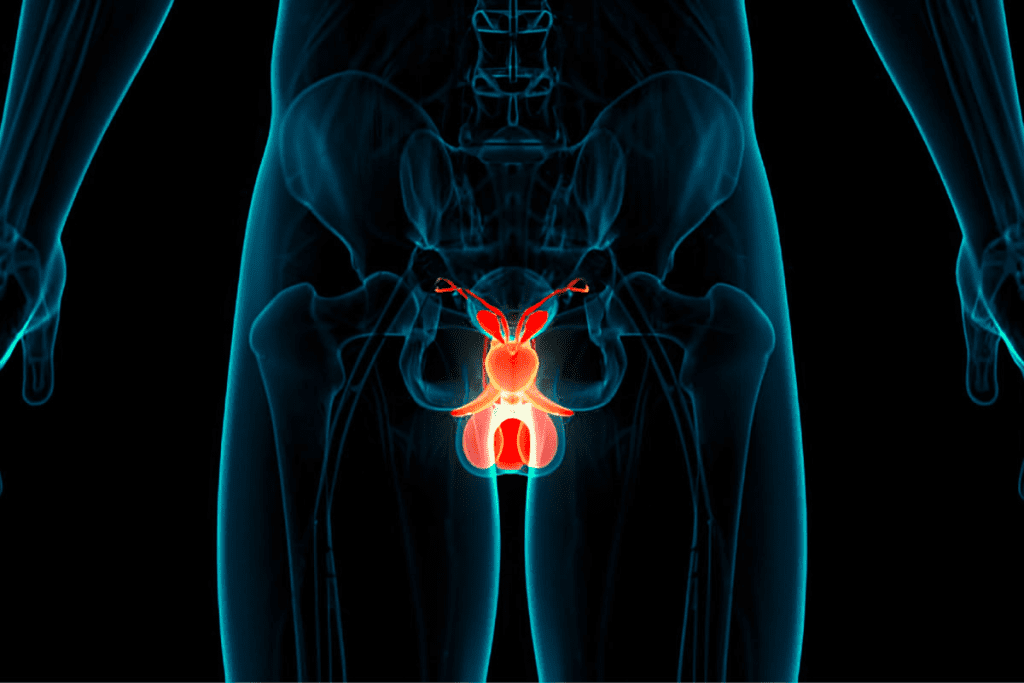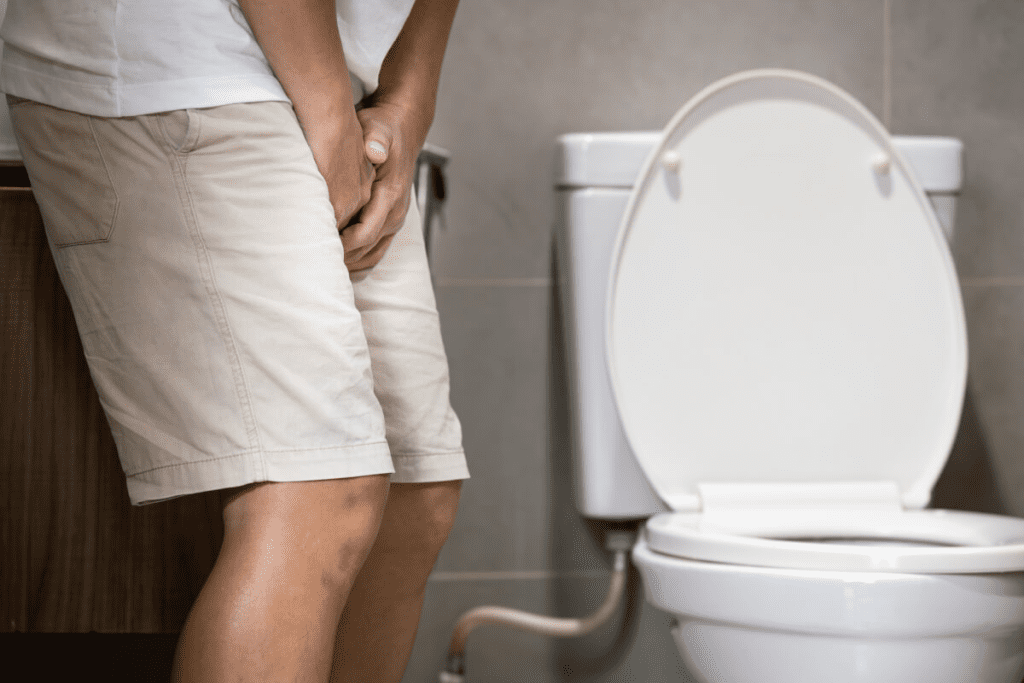Last Updated on November 25, 2025 by
A weak urine flow is when urine comes out slowly or in a dribble, causing trouble urinating. It can be hard to start or keep going. This problem can happen to both men and women. But men are more likely to face it because of an enlarged prostate.

Studies show that up to 50% of men over 50 have weak urine flow. This is often because of an enlarged prostate. We will look into what weak urine flow is, why it happens, and why you should see a doctor.
Understanding weak urine flow is key to spotting urinary problems. A weak flow can show up in various ways. Knowing these signs can help you get medical help if needed.
A slow and dribbling stream is a main sign of weak urine flow. It means there might be an issue that needs fixing. The urine may not flow well, causing a dribble. This can also mean discomfort or pain when you pee, which is a worry.
Another sign is needing to strain to start and keep the flow going. People with weak urine flow might have to strain or push to pee. This can be uncomfortable and might show a bigger problem.
Stream strength that changes is also a big sign. The flow might stop and start, or get stronger and weaker. This can make peeing unpredictable and uncomfortable. It could mean there’s a health issue that needs a doctor’s check.
Spotting these signs is important for finding weak urine flow and getting medical help. If you notice any of these, see a doctor right away. They can find out why and help you get better.
Trouble urinating is common among men, more so as they get older. Knowing the causes is key to managing and treating it. We’ll look at the main reasons for weak urine flow in men, like BPH, age-related changes, and other urological issues specific to men.
Benign prostatic hyperplasia (BPH) is a non-cancerous growth of the prostate gland that affects many men as they age. This growth can narrow or block the urethra, leading to a weak urine stream. BPH is a major cause of weak urine flow in men over 50. Symptoms include:
BPH is not cancer, but it can greatly affect a man’s quality of life. Treatment varies from medication to surgery, based on symptom severity.
Age-related changes play a big role in weak urine flow in men. By age 50, about 50% of men have urinary symptoms due to BPH or other age-related changes. As men age, their prostate gland grows, which can narrow the urethra and slow urine flow.
Other age-related factors include weaker bladder muscles and less ability to empty the bladder fully. These can cause symptoms like:
Other male-specific urological conditions can also cause weak urine flow. These include:
These conditions can lead to symptoms like weak urine flow, painful urination, and trouble starting or stopping urination. Getting a correct diagnosis from a healthcare professional is vital to finding the right treatment.

Several factors can cause weak urine flow in women, affecting their daily life. We’ll look at the main causes, like pelvic floor issues, bladder prolapse, and chronic UTIs.
Pelvic floor dysfunction is a big reason for weak urine flow in women. These muscles help control when we pee. If they get weak, it can cause problems like slow or weak urine flow. Things like childbirth, getting older, and some health issues can weaken these muscles.
Key symptoms of pelvic floor dysfunction include:
Bladder prolapse happens when the bladder pushes into the vagina. This can make urination weak. Women with this issue might have mild or severe incontinence problems.
The symptoms of bladder prolapse can include:
Chronic UTIs are another main cause of weak urine flow in women. UTIs happen when bacteria infect the urinary tract. This can cause long-term damage and weak urine flow.
Common effects of chronic UTIs include:
It’s important to know the warning signs of a weak urine flow. This can mean there’s an underlying issue that needs to be checked.
Abdominal pain and pressure sensations are key warning signs. This discomfort can be mild or severe and may come and go. It shows something is wrong in the urinary tract.
Another important sign is the feeling of incomplete bladder emptying. This feeling can be unsettling and may make you try to urinate often. It means your bladder isn’t working right.
Frequent urination with minimal output is another warning sign. This can be frustrating and may mean there’s an obstruction or other urinary tract issues. It’s important to watch how often and how much you urinate.
A split urinary stream or spraying of urine is also a symptom that needs attention. This can happen for many reasons, like urethral obstruction or other urological conditions.
Other symptoms include chills, fever, vomiting, and lower back pain. If your urine stream stops, it can cause urinary retention, which is an emergency. Spotting these signs early can greatly help in treatment.
We must watch for these warning signs and see a doctor if they don’t go away or get worse. Early treatment can stop complications and improve your urinary health.
It’s important to know the risks of chronic weak urine flow for our urinary health. A weak stream when we pee can signal serious problems. If not treated, these issues can worsen and affect our health greatly.
Low urine flow raises the risk of urinary tract infections (UTIs). A weak stream can cause the bladder not to empty fully. This creates a perfect spot for bacteria to grow, leading to UTIs that can be painful and hard to treat.
Chronic weak urine flow also increases the chance of bladder stones. If the bladder doesn’t empty well, urine gets too concentrated. This can cause minerals to crystallize and form stones, leading to pain and possibly needing medical help.
Long-term weak urine flow can harm bladder function. The bladder muscle gets stretched and weak, making it hard to empty. This can start a cycle where the bladder gets worse over time, leading to problems like urinary retention.
Chronic weak urine flow can also harm our kidneys. Issues like urinary retention and infections can damage the kidneys. In severe cases, this could lead to chronic kidney disease or make existing kidney problems worse. It’s vital to address weak urine flow quickly to protect our kidneys.
In summary, the risks of chronic weak urine flow highlight the need for medical help. By treating the root causes of weak urine flow, we can avoid serious health problems. This helps keep our urinary system healthy.
A weak or slow urine flow can be a sign of a serious health issue. We’ll help you know when to get medical help. Look out for urgent signs, gradual changes, and risk factors that mean you should see a doctor.
Chills, fever, or vomiting with a weak urine stream mean you need to see a doctor right away. These could be signs of a serious infection or other health problems. Also, if your urine stops flowing, go to the doctor fast.
Other urgent signs include severe stomach pain, a lot of blood in your urine, or trouble peeing. These can mean you have a blockage or a bad infection.
Slowly getting weaker or more frequent urination can mean you have a health problem. If you notice these changes, see a doctor. Issues like BPH or pelvic floor problems can cause these symptoms and need medical help.
Some things make it more likely you’ll have problems with slow urination. Men over 50 are at higher risk because of prostate issues. Other risks include past UTIs, bladder or prostate problems, and neurological conditions. If you have these risks and notice changes, talk to your doctor.
Going to the doctor might seem scary, but it’s important. Early treatment can make a big difference. Knowing the signs and risks helps you take care of your urinary health.
Healthcare professionals use different methods to find out why urine flow is weak. These methods help find the main reasons for urinary problems.

First, we do a detailed physical check and look at your medical history. We check your overall health and look for any unusual signs. We also ask about your symptoms and past health issues. This helps us figure out what might be causing the weak urine flow and what tests we need next.
Urodynamic testing checks how well the bladder and urethra work. It measures the urine flow’s strength and consistency. These tests give us important information about how well the bladder is working and help us find the cause of urinary problems.
Imaging studies, like ultrasound, let us see the urinary tract and find any problems. We might use X-rays or CT scans too, depending on what we think might be wrong. These studies are key to understanding the urinary system’s structure and function.
Laboratory tests, like urinalysis and urethral swabs, help find infections or inflammation. We might also do bladder scans or other tests to check bladder function. These tests help us find the main cause of weak urine flow.
By using all these methods together, we can find the real cause of weak urine flow. This helps us create the best treatment plan. Knowing the exact cause of urinary problems is key to giving the right care and improving patient results.
It’s important for patients to know about treatment options. We’ve talked about the causes and problems of weak urine flow. Now, let’s look at the treatments available.
Treatment for weak urine flow varies based on the cause. It might include pelvic floor exercises and watching fluid intake. Medications can also help by relaxing or shrinking the prostate. Sometimes, medical procedures are needed to fix underlying issues.
With a healthcare provider’s help, patients can get a treatment plan that fits their needs. This can improve their life quality. The right treatment can help manage symptoms, prevent problems, and enhance urinary health.
Symptoms include a slow and dribbling stream. You might need to push to start and keep the flow going. The stream’s strength can change, and you might feel pain in your abdomen.
You might feel like you didn’t empty your bladder fully. Also, you could find yourself needing to pee a lot but only getting a little out.
In men, it’s often due to Benign Prostatic Hyperplasia (BPH). Age also plays a role. Other urological issues specific to men can cause it too.
For women, it’s usually because of pelvic floor dysfunction. Bladder prolapse and chronic urinary tract infections are also common causes.
Look out for abdominal pain and pressure. Feeling like you didn’t empty your bladder is a warning sign. Also, needing to pee a lot but not getting much out is a sign.Another warning is if your urine stream splits or sprays.
Chronic weak urine flow can lead to serious issues. These include a higher risk of urinary tract infections. You might also develop bladder stones.It can impair your bladder function long-term. Kidney problems can also arise.
If you notice urgent warning signs, seek help right away. Gradual changes or risk factors also warrant medical attention.
Diagnosis starts with a physical exam. Urodynamic testing and flow rate measurement follow. Imaging studies like ultrasound are also used.
A slow urine flow can signal a medical issue. This could be BPH, pelvic floor dysfunction, or other urological problems.
Yes, there are treatments for weak urine flow. The right one depends on the cause. A healthcare professional can guide you.
Timely medical attention is key. It can prevent issues like urinary tract infections and bladder stones. It also helps avoid long-term bladder problems.
Subscribe to our e-newsletter to stay informed about the latest innovations in the world of health and exclusive offers!